On Jan. 27, about 300 people enjoyed what was called the Photorogaining & TOKYO competition, uploading photographs of various locations in Tokyo on social media to share the allure of the Japanese capital with the rest of the world.
“Photorogaining” is a combination of “photography” and “rogaining.” The latter is “the sport of long-distance cross-country navigation,” according to the Australia-headquartered International Rogaining Federation, established in 1986. It says the sport has various elements, such as “teamwork, endurance, competition and a respect for the natural environment,” involving route planning and navigation between checkpoints with the use of a variety of map types.
The Photorogaining & TOKYO event was aimed at creating an opportunity for the participants, called rogainers, to discover Tokyo’s attractive spots that many of them had been previously unaware of. They departed from, and returned to, Akihabara in teams of two to five people, finding checkpoints designated on a special map, while taking photographs as they walked. They competed to collect as many points as possible within a specified time, with various checkpoints having different point values.
A total of 39 checkpoints existed, including Zoshigaya Kishimojindo temple in Toshima Ward, Tokyo Tower in Minato Ward, the Jingubashi bridge that connects Harajuku Station with the Meiji Jingu shrine in Shibuya Ward, and the Kabukiza Theatre in Chuo Ward. As the destinations were so geographically scattered, and participants had a time limit of three hours, all teams were eligible, as a special rule, to use trains and buses as needed.
A complete tour of all the checkpoints would be worth a maximum score of 1,500 points. Points varied — a team reaching Zoshigaya Kishimojindo, one of the distant checkpoints, gained 100 points, while a visit to East Japan Railway Group’s defunct Manseibashi Station on the Chuo Line, now renovated as a multifaceted shopping facility named the “mAAch ecute,” added only 12 points as it is close to the starting point. As such, each team was able to enjoy planning photorogaining routes on their own to accumulate as many points as possible.
On the morning of Jan. 27, one team after another showed up at Akihabara UDX, where the event started and finished, to register at the reception desk and receive the competition map. Reiko Wada, a 46-year-old company employee in Tokyo, was one of the rogainers who arrived early. Her team “will definitely go to Zoshigaya Kishimojindo and get 100 points there,” she said.
At 10 a.m., the event kicked off with teams fanning out from Akihabara. Shortly after 11 a.m., the Tokyo duo of company employee Yoji Nakamura, 34, and his colleague Makoto Uehara, 35, arrived at Zoshigaya Kishimojindo, which is a government-designated important cultural property. After offering prayers at the temple, Nakamura said, “We’re really enjoying [photorogaining]. It’s just like a game as we run from one sightseeing spot to another.” Then, they left for their next checkpoint — Mt. Hakone in Toyama Park, Shinjuku Ward.
Inside Tokyo’s Yamanote Line loop, Mt. Hakone is the highest man-made piece of land at 44.6 meters above sea level. A large number of photorogaining teams visited the mountain, with many running up the steep, snow-covered slope to take photos at the summit’s checkpoint.
Just before 1 p.m., or almost three hours after the first teams left Akihabara, some teams were seen dashing to the goal. Each team photographed the clock at the finishing line so that they were able to finally calculate their respective amounts of points earned.
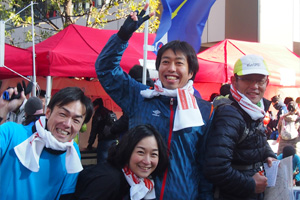 Participants begin the three-hour event.
Participants begin the three-hour event.
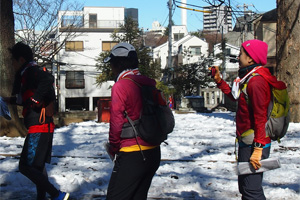 Photographing a teammate
Photographing a teammate
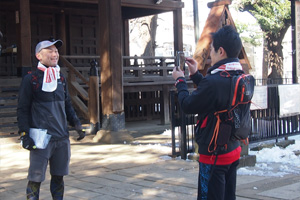 Zoshigaya Kishimojindo, a 100-point checkpoint
Zoshigaya Kishimojindo, a 100-point checkpoint
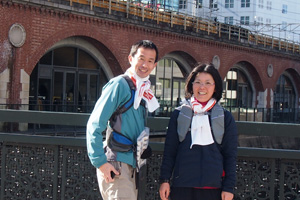 The former Manseibashi Station near Akihabara
The former Manseibashi Station near Akihabara
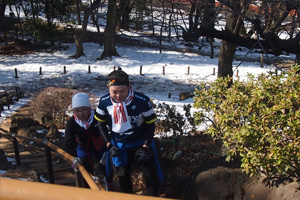 Running up Mt. Hakone in Shinjuku Ward
Running up Mt. Hakone in Shinjuku Ward
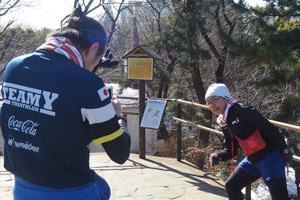 Photographing at Mt. Hakone
Photographing at Mt. Hakone
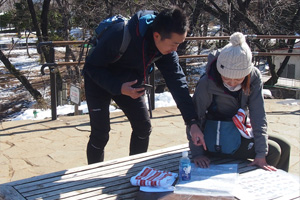 Checking photorogaining routes
Checking photorogaining routes
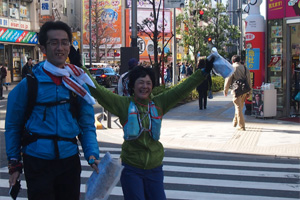 Participants returning to Akihabara
Participants returning to Akihabara
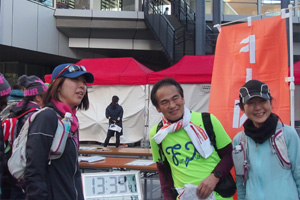 Confirming the finish time
Confirming the finish time
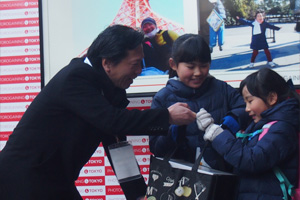 Award winners rejoice.
Award winners rejoice.
The event’s Special SNS (social networking system) Awards were presented to three teams for uploading excellent photos on social media during the competition.
The Teamwork Award was given to the team of Haruyo Motoyama, a 50-year-old homemaker from Chiba Prefecture, and three sixth-year elementary school students, including her daughter. “We walked, ran and photographed together for three hours. So, I think they made great memories,” said Motoyama, referring to the three classmates who are to enter different middle schools in April.
The Smile Award went to a team and the Best Dressers Award was presented to another team.
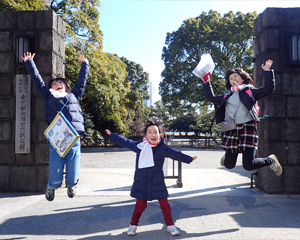 Smile Award
Smile Award
Jumping at the Hamarikyu Onshi Teien Garden in Minato Ward
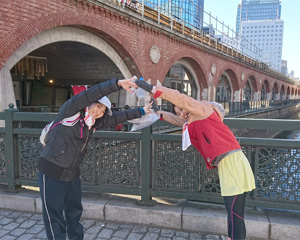 Best Dressers Award
Best Dressers Award
Photographed on the Kanda Manseibashi bridge in Chiyoda Ward
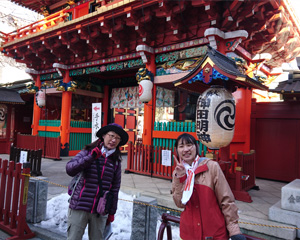 Best Dressers Award
Best Dressers Award
Photographed at the Kanda Myojin shrine in Chiyoda Ward
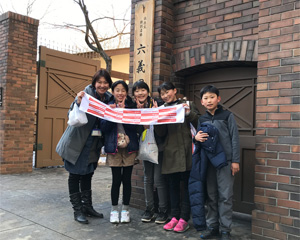 Teamwork Award
Teamwork Award
A housemaker and three girls at the Rikugien Garden in Bunkyo Ward
Forming a team called Mateo Sensei, company employee Kazuhiko Watanabe, 45, and his colleague Ryoko Aosaki, also 45, garnered the highest score of 845 points to win the event. They went through 15 checkpoints, continuing to run through all the related legs but also using a JR line, the Toden Arakawa-sen streetcar line, a subway line and then a bus route to save time.
“This was our first photorogaining experience.” Watanabe said, “It’s a valuable opportunity to know more about Tokyo. I rode a streetcar for the first time.” For her part, Aosaki said she was familiar with the areas the pair toured in the event — including the public transportation systems they used. Nonetheless, she said, “The three-hour duration was a shorter timeframe than had been expected. After two hours, we decided to skip many of the places that had been in our original itinerary.”
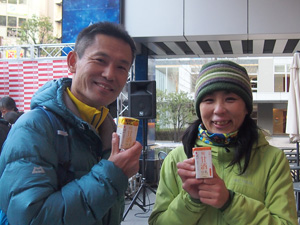 Kazuhiko Watanabe and Ryoko Aosaki forms a team named “Mateo Sensei.”
Kazuhiko Watanabe and Ryoko Aosaki forms a team named “Mateo Sensei.”
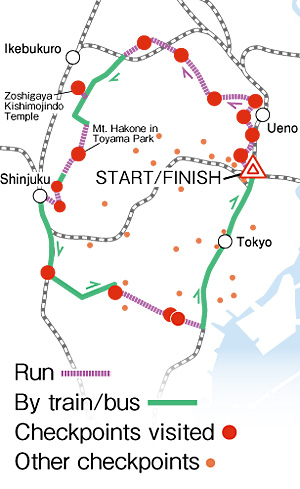 Photorogaining & TOKYO
Photorogaining & TOKYO
Winning team’s trail
On the day of the photorogaining competition, a special program was given at Akihabara UDX, the starting and finishing point, to make Akihabara better known globally. The event featured unique digital goods that used state-of-the-art technologies. The Japanese artist known as John Hathway presented a live drawing performance to illustrate Akihabara’s near-future scenes.
The Photorogaining & TOKYO event was organized by The Yomiuri Shimbun under the joint auspices of the Tokyo Metropolitan Government and the Tokyo Convention & Visitors Bureau. Communication marketing company MINDSHARE Inc. managed the event under the supervision of the Japan Photo Rogaining Association.
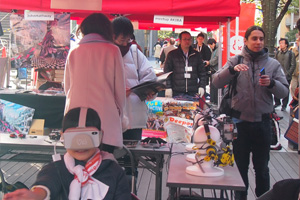 An event-related display of digital goods
An event-related display of digital goods
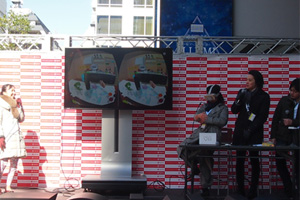 Various events, including virtual reality (VA) experiences, are held at the main Photorogaining & Tokyo stage in Akihabara.
Various events, including virtual reality (VA) experiences, are held at the main Photorogaining & Tokyo stage in Akihabara.
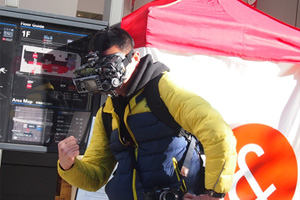 A Photorogaining & Tokyo participant uses a wearable gadget.
A Photorogaining & Tokyo participant uses a wearable gadget.
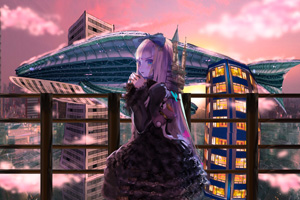 A near-future Akihabara scene created by artist John Hathway during a live drawing performance at the Photorogaining & Tokyo event
A near-future Akihabara scene created by artist John Hathway during a live drawing performance at the Photorogaining & Tokyo event
The Photorogaining & Tokyo event was held as part of the Tokyo Brand Promotion Campaign organized by the Tokyo Metropolitan Government. The “&” in the Tokyo branding logo expresses Tokyo’s numerous ways of creating new kinds of enjoyment by forming new values and connections. Any word that describes an experience or attraction of Tokyo can be added ahead of the “& Tokyo” platform — as in the cases of “Art & Tokyo” or “Fashion & Tokyo” among many other examples.